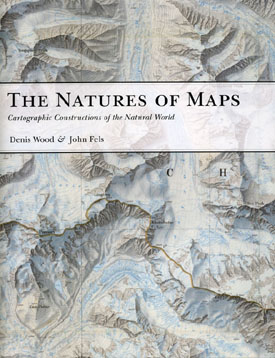 You may wonder why the pages of Green Man Review, a ‘zine devoted to the roots of arts and culture, which purview most often results in insightful and intelligent studies of music, speculative fiction, and film, should play host to a discussion of a book on maps. Well, the subtitle of The Natures of Maps may give you a hint: the book is about “Cartographic Constructions of the Natural World.”
You may wonder why the pages of Green Man Review, a ‘zine devoted to the roots of arts and culture, which purview most often results in insightful and intelligent studies of music, speculative fiction, and film, should play host to a discussion of a book on maps. Well, the subtitle of The Natures of Maps may give you a hint: the book is about “Cartographic Constructions of the Natural World.”
The key word here is “constructions.” As John Pickles points out in his foreword, what Fels and Wood are doing here is asking their readers — us — to take maps seriously as tools for creating meaning, “part of a conversation of how we understand the world.” We’ve run into this concept before, the idea of “discourse” as a pointed and rigorous examination of phenomena, and it’s a very useful one, particularly for those involved in the arts in any way — creators, commentators, audience. Another statement of this idea, quoted in the first chapter, was provided by J. B. Hurley, “the map is not the territory, yet if often precedes, and even becomes that territory.” Perhaps it’s not so surprising that I immediately thought of René Magritte’s painting, Ceci n’est pas une pipe.
The first section of The Natures of Maps deals with the way the map becomes the territory. The authors are quick to point out the essential ambiguity in the phrase underlying Harley’s statement: it is about the nature of maps, but could equally be about the nature of maps. It’s a subtle shift in emphasis, but absolutely necessary to build a clear understanding of the book’s main argument, which is that maps of the natural world are as much social/ideological constructs as are maps showing political boundaries or anything else.
The key element here is the simple fact that maps are images composed of signs and so, like any other sign system, rely on social assent (we all agree on what the signs mean) and an element of reciprocity that derives from their authority as reference items (we all agree that maps depict a commonly accepted reality, and we all accept their depiction). In regard to maps, this reciprocity extends down to their basic proposition (and the authors take the map not as a graphic depiction or an object, but a series of propositions forming an argument). Maps make the claim that “this is there,” but “thisness” and “thereness” — existence and location — must share a conceptual space to have any authority. That authority, as noted, derives from social assent. We all agree that “this is there” is a valid proposition, and that, assuming the mapmaker was at all competent, any given instance describes a reality we accept as true.
The second chapter’s content is self-evident from its title: “The propositional logic of the map.” If, indeed, a map is a set of propositions forming an argument, then it follows that it relies on a logical framework to make its case. For the reader unused to the processes of formal logic, this one might be heavy going, but it does provide the conceptual underpinnings for the idea of maps as creators of reality. This chapter is mostly the formal explication of the ideas advanced in Chapter One, and leads into an example in Chapter Three, “Reading ‘Land of the Living Fossils.'” Part of this illustration is the discussion of the epimap and the perimap, which together make up the paramap, the “surround,” both external and internal, that gives the map’s argument its force and consequently, a large measure of its authority. This surround includes things that may appear on the map, such as titles, illustrations, legends, scale bars, and the like (the “perimap”) and things that are external to the map, such as accompanying articles (readers of National Geographic will be familiar with this one), advertisements and marketing copy, and other materials that describe the map itself (the “epimap”).
The second part of the book takes the reader through a number of different ways in which maps create realities for nature — nature as a fragile, threatened environment, nature as a place of hazard, nature as a cornucopia of plenty, and the like, detailing the ways in which maps and their paramaps create these realities.
I have to confess that when faced with a work such as The Natures of Maps, I begin to think that perhaps the human intellect has gotten too subtle and perceptive — we can no longer take anything at face value. And then I remember that a large portion of what I do — in these pages perhaps more than anyplace else — is to decline, more or less politely, to take anything at face value. It’s when I run across concepts such as those presented there that I start to get really excited. The Natures of Maps describes not only what is happening when we look at a map, but what is happening when we listen to a recording of traditional or modern music or read a work of fantasy or history and comment on it, either informally among friends, or perhaps more formally in venues such as this: we are participating in the creation of realities. And I’ve long maintained that to be able to do that sort of thing with clarity and accuracy, the one necessary tool is vocabulary. That’s why I’m so delighted with this book, which has application far beyond its stated subject: Wood and Fels have given us another glossary to use.
(University of Chicago Press, 2008)
